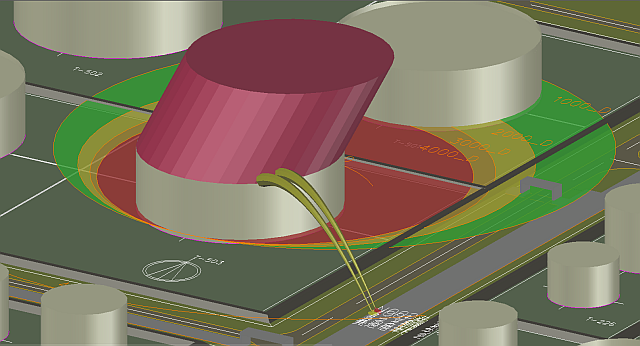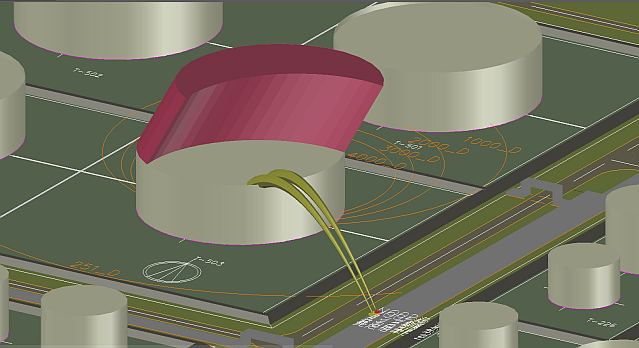Tank Fire Extinguishing Simulation
This program was developed to simulate the fire extinguishing method for the full surface fire of floating roof tank by large-capacity foam monitors. This program calculates the fire extinguishing time which is sum of the time required to establish the foam bridge head on the burning liquid surface and the time required for foam spreading to whole burning surface. Furthermore, this program has a function to determine the appropriate location of the foam monitor under any wind condition and a function to map the safe range of firefighting activities by heat radiation calculation. It can be applied not only to floating roof tank fires but also to fire extinguishing simulations of fixed tank full surface fires with using fire trucks and foam monitors.
This PC program includes various calculations described below. Foam spreading speed and loss of foam are based on the experimental report " FOAMSPEXS" by SP Swedish National Testing and Research Institute.
- Trajectory simulation for foam stream and foam loss during flying
- Heat flux calculations to confirm safety for fire fighters and mapping of foam monitors etc.,
- Thermal updraft speed calculation above burning surface of the tank and calculation of foam loss by the updraft.
- Prediction about the time required for establishment of foam bridge head on the burning surface.
- Calculation the time required for foam spreading all over the fuel surface.
|
Experience the simulation
|
Foam Discharge and Thermal Updraft
Foam discharged from a foam nozzle will be affected strongly by wind, and foam will be blown off to yield foam loss. While on the fired tank, there exists the thermal updraft, which speed is increased as closing to the center of the tank and as distancing from the burning surface. Therefore, foam application should be onto the burning area near the periphery of the tank or to the very narrow elevation space above burning fuel surface of the tank. The former is called as sweet spot method and the latter is as foot print method. FPEC recommends sweet spot method, but our PC program is applicable foot print method also.
Figure 1 shows that foam is discharge onto the sweet spot of the fired tank from two large foam monitors. Black column on the tank means zone of higher updraft speed caused by a fire. Foam will be blown off within the zone, so the program will decide this discharge is not adequate if discharged foam touches the black column. When foam discharge is just onto the sweet spot, then color of the foam stream is changed to gold.
Figure 1 ;foam discharge and thermal updraft

Foam Spreading and Extinguishing Fire
Foam applied onto the burning surface will be vaporized and disappeared due to high temperature of the fuel surface. But when continuing foam application onto the same point, the portion of the fuel surface will be cooled down and foam can be accumulated to establish the foam bridge head. Once foam bridge head is established, foam can spread on the burning surface and finally fire will be extinguished when overall surface is covered by foam.
The time required to establish the foam bridge head is much longer than ones for foam spreading.
Figure 2 shows that formation of foam bridge head is now proceeding. Until foam bridge head is established, the force of the fire will be maintained.
Figure 3 shows that foam is spreading and fuel surface having been covered by foam has been extinguished. The heat flux has been decreased according to foam spreading.
Figure 2;foam discharge and foam bridge head
Figure 3 foam spreading and extinguishing fire


